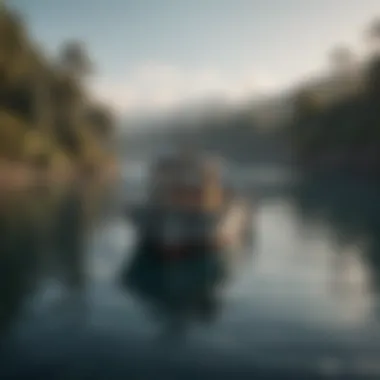Wide Fishing Boats: Essential for Sustainable Fisheries


Overview of the Topic
The fishing industry, often romanticized for its adventurous spirit and community bond, hides layers of complexity behind its facade. Wide fishing boats, quietly operating in the backdrop, play a quintessential role in sustainable fisheries management. Unlike their narrower counterparts, these vessels are designed for stability and spaciousness. This leans them to be more effective in various fishing methods while minimizing harm to marine habitats. Their design isn't just for looks; it reflects a deep understanding of how to coexist and thrive within the intricate balance of marine ecosystems.
Understanding the significance of these boats transcends mere vessel analysis. It's pivotal to grasp how they aid in maintaining fish populations and preserving the delicate web of ocean life. With rising concerns about stock depletion and environmental degradation, the conversation around the potential of wide fishing boats is both timely and necessary.
Current Status and Challenges
Examining the present condition of fisheries, one can observe a concerning trend. Overfishing and poor management practices continue to threaten livelihoods and ecosystems alike.
Several challenges confront the fishing sector today:
- Climate Change: Rising temperatures affect fish migration patterns, leading to mismatches between stock availability and fishermen’s capabilities.
- Regulatory Pressures: Laws aimed at protecting marine life often clash with the economic interests of fishing communities.
- Technological Gaps: Not all wide fishing boats are equipped with modern technology to ensure eco-friendly operations, making them less competitive in a rapidly evolving market.
These issues underscore the need for innovative solutions. It is not just about keeping the boats afloat; it’s also about keeping the marine ecosystems healthy.
Sustainable Solutions
As the old saying goes, "Necessity is the mother of invention." In the realm of wide fishing boats, this rings true. Many are now integrating sustainable practices that leave less of a footprint. Here are some notable advancements and practices:
- Eco-Friendly Materials: Using materials that are less harmful to the environment is gaining traction. Innovations in biocomposites can lead to reduced waste.
- Advanced Monitoring: Technologies such as GPS and sonar help fishermen identify healthy populations, which aids in adhering to sustainable harvest practices.
- Community Involvement: Engaging local communities in decision-making not only yields better outcomes but also fortifies social bonds among fishermen.
An example worth mentioning is the Green Marine Initiative, where fishermen participating in eco-friendly practices are rewarded with reduced licensing fees. This approach provides a dual benefit—promoting sustainable fishing while easing the financial burden on local fishers.
Impact and Importance
The ripple effect of adopting wide fishing boats into sustainable fisheries stretches far and wide. Their significance echoes through various channels:
- Ecosystem Health: By reducing overfishing, these vessels help ensure the future viability of important fish species, promoting biodiversity.
- Community Sustainability: Fishing is often the lifeblood of coastal communities. By investing in sustainable practices, these communities can secure their futures.
- Future Generations: The commitment to utilizing such boats in fisheries management reinforces the idea that we must think beyond our immediate needs, nurturing resources for those yet to come.
It's imperative to remember that sustainable practices today are investments in the ocean's future; a healthy ecosystem can support thriving communities and robust economies.
The integration of wide fishing boats into the sustainable fisheries conversation is not merely beneficial—it is essential. As fish populations continue to dwindle globally, taking steps to better understand and leverage these vessels can lead to an aligned approach between economic growth and environmental stewardship.
Prelude to Wide Fishing Boats
Wide fishing boats serve as a pivotal element in the conversation surrounding sustainable fisheries. Their design and operational characteristics are not merely accidents of nautical engineering; they represent a thoughtful response to the increasingly pressing need for ecological balance and economic viability. With marine life under constant threat from overfishing, pollution, and habitat destruction, these vessels emerge as unsung heroes, balancing the scales between human activity and environmental preservation.
Definition and Characteristics
Wide fishing boats, distinct from their narrow counterparts, are characterized by their broader beams and increased stability. This width offers numerous advantages, such as greater deck space for equipment and crew, and improved buoyancy in turbulent waters. The structural features allow for diverse fishing techniques, accommodating different target species and fishing methods. It’s not just about size, though; the layout often prioritizes efficiency and safety. On deck, you might find designated areas for sorting catch, minimizing stress on fish and ensuring better quality.
These boats often utilize materials like aluminum and fiberglass, which are both lightweight and durable, providing longevity while reducing fuel consumption. Additionally, many are equipped with advanced fishing technology, including eco-friendly nets designed to minimize bycatch.
Historical Context
The evolution of wide fishing boats has roots entrenched in the history of maritime culture. As societies began to heavily depend on fishing for subsistence and trade, the need for more efficient vessels became apparent. Historical evidence points to designs that date back centuries, with fishermen initially using small, sturdy boats. Over time, as communities grew and demands increased, so did the necessity for wider structures.
By the mid-20th century, the impact of industrial fishing was starkly felt. The depletion of fish stocks and the consequent realization of sustainable practices catalyzed a shift. Innovators in boat design started incorporating wider beams to address the issues of stability and environmental friendliness.
"Sustainability in fishing is not just a guiding principle; it's a lifeline for the future of our oceans."
Contemporary wide fishing boats stand as a testament to this journey, merging traditional knowledge with modern technology. By balancing the need for efficient operation with ecological responsibility, these vessels not only safeguard livelihoods but also protect the invaluable resources they rely on.
Design Aspects of Wide Fishing Boats
The design aspects of wide fishing boats are not just aesthetic choices; they play a crucial role in the functionality, sustainability, and overall impact of these vessels on fisheries. Understanding their structural features and the many advantages of their width can illuminate why they are considered pivotal in reducing the ecological footprint associated with traditional fishing practices.
Structural Features
When it comes to wide fishing boats, one can’t overlook their structural components, which are meticulously crafted to enhance both durability and efficiency. Typically, these vessels are constructed with broader beams and reinforced hulls, allowing them to withstand the tumultuous nature of marine environments.


- Material Choices: Made primarily from aluminum or fiberglass, the lighter weight of these materials complements the larger dimensions, providing flexibility while maintaining strength. Such materials also resist corrosion better than traditional wooden boats.
- Stability and Buoyancy: The wider base significantly increases buoyancy. This is particularly valuable in rough seas, enabling these boats to remain upright when the waters become choppy. Fishermen can work with greater confidence, which ultimately leads to a safer fishing environment.
- Design Ergonomics: These boats are often designed with larger decks, better storage amenities, and more accessible fishing stations, which enhance crew efficiency and comfort during long hours at sea.
In sum, the structural features of wide fishing boats are tailored to ensure that performance is never compromised, especially in sustaining fisheries through environmentally responsible practices.
Advantages of Width
The width of these vessels is their secret weapon. It might sound counterintuitive, but wider boats provide several advantages that directly impact sustainability and operational efficiency.
- Greater Workable Surface Area: With a wider layout, crews can operate with less crowding. This space is essential when it comes to sorting catches and minimizing stress on both crew and fish. Additionally, a more accommodating workspace translates into effective teamwork and better handling of the day’s catch.
- Reduced Fuel Consumption: A wider design can have a positive effect on fuel efficiency. The boat's shape allows for smoother navigation through the water, which can lead to a decreased rate of fuel usage over long distances. Thus, not only does a wider ship enhance sustainability, but it also helps fishers save on operational costs.
- Improved Safety: A wider boat is less likely to capsize in rough seas, which adds a layer of safety that is paramount for crews. In a field often wrought with unpredictable conditions, having reliable equipment can be the difference between a routine day and one fraught with peril.
- Minimized Bycatch: Advanced designs allow for targeted fishing practices, meaning that the likelihood of bycatch—unintended catches—decreases. The broader boats can accommodate instruments and technology aimed at refining fishing methods, which ultimately promotes a healthier marine ecosystem.
"Wide fishing boats may seem like a mere trend in design, but their true value lies in their ability to harmonize fishing practices with environmental stewardship."
In essence, the advantages of width in fishing boats are multi-faceted, contributing not just to operational efficacy but also towards a critical form of stewardship in marine resource management.
Operational Benefits
Understanding the operational benefits of wide fishing boats is essential for grasping their pivotal role in sustainable fisheries. These advantages transcend mere functionality; they embody a philosophy of efficiency and ecological mindfulness that is crucial in today's fisheries management landscape. In this section, two significant benefits will be explored in detail: stability in various conditions and fuel efficiency.
Stability in Various Conditions
Wide fishing boats are celebrated for their remarkable stability during fishing expeditions. The inherent design, which features a broader beam, plays a critical role in ensuring that these vessels can navigate rough waters without compromising safety or catch quality. Compared to their narrow counterparts, the wider hulls provide superior buoyancy, especially in tumultuous conditions.
When out at sea, conditions can turn on a dime. Choppy waves and sudden storms can create perilous situations for fishing crews. Wide fishing boats are built to withstand such challenges more effectively due to their lowered center of gravity. This stability minimizes the likelihood of capsizing and allows fishermen to work diligently without the added stress of a wobbly vessel. Moreover, this fortified stability translates to better crew morale and productivity.
Utilizing these boats in adverse weather has additional positive implications. For instance, having a stable platform permits the implementation of more effective fishing techniques even in harsher conditions. Consequently, not only are the safety of the crew preserved, but the catch rates can also be enhanced. This reliability is a game-changer, not just for the fishermen, but for the fishing industry as a whole, pushing towards sustainable and responsible fishing practices.
Fuel Efficiency
Turning our attention to fuel efficiency, wide fishing boats showcase another crucial operational advantage—conserving resources while maximizing output. These vessels, with their design focused on hydrodynamics, tend to glide through water more smoothly compared to traditional fishing boats. By reducing water resistance, they use less fuel to cover greater distances, leading to both economic savings and lower carbon emissions.
In the fishing industry, where profit margins can be tight, the impact of fuel efficiency is significant. When fishermen reduce fuel consumption, they also lower operational costs, allowing for more sustainable practices across the board.
Moreover, the shift towards fuel-efficient vessels aligns seamlessly with global sustainability goals. The use of advanced materials and designs not only makes wide fishing boats eco-friendlier but also encourages further innovation in the industry. This progress is essential to creating a more responsible fishing culture that respects current environmental standards and addresses future challenges.
"Wider hulls are not just a feature; they are a commitment to better fishing practices that prioritize both safety and the environment."
In summary, the operational benefits of wide fishing boats offer a dual opportunity: enhancing the safety and effectiveness of fishing operations while supporting broader environmental objectives. Their ability to withstand harsh conditions and consume fuel more efficiently places them at the forefront of sustainable fisheries. With these advantages, wide fishing boats are positioned as vital allies for fishermen aiming to preserve marine ecosystems while meeting the needs of a growing market.
Environmental Impact of Wide Fishing Boats
The relevance of wide fishing boats stretches far beyond their operational capabilities; they play a crucial role in shaping our marine ecosystems and promoting sustainable fishing practices. Within the realm of environmentally friendly fisheries management, these vessels stand out for their ability to minimize negative impacts while maximizing efficiency. Understanding the environmental impact of wide fishing boats requires a close examination of sustainability practices and the reduction of bycatch, both of which are integral to the future of sustainable fisheries.
Sustainability Practices
Wide fishing boats are often designed with sustainability at their core. Their width allows for the implementation of several eco-friendly practices that set a benchmark for the industry.
- Efficient Use of Resources: Wider boats enhance the ability to carry more catch, reducing the need for multiple trips and consequently cutting down on fuel consumption. A common saying in fishing circles is, "It’s not about catching more but catching smart." This sentiment encapsulates the heart of sustainable practices—maximizing yield while minimizing waste.
- Eco-Friendly Materials: Some manufacturers are leaning toward using materials that are less harmful to the environment, such as recycled metals or sustainably sourced wood. These choices may seem small, but collectively they can lead to significant environmental benefits over time, reinforcing the commitment to sustainability.
- Community Engagement: Many fishing communities using wide boats are increasingly adopting tools like regular ecological assessments, ensuring locals are aware of their impact on the ecosystem. This engagement fosters a sense of responsibility toward ocean health and biodiversity.
The efforts don't end here. There's a shift in mindset among fishermen who recognize that long-term viability depends on ocean health. Adapting their practices ensures that future generations can rely on the same resources, making it a point of pride rather than just a necessity.
Minimization of Bycatch
One of the hallmark benefits of using wide fishing boats is their ability to significantly reduce bycatch—fish that are caught unintentionally while targeting other species. This reduction is critical for maintaining balanced marine ecosystems. Let's delve into the specifics:
- Selective Gear: Many wide fishing boats come equipped with specially designed gear that lowers bycatch rates. For instance, certain net designs allow smaller and non-target species to escape while still catching the desired fish. This practice is sometimes referred to as using "smart nets," illustrating an evolving fishing philosophy that prioritizes ecological balance.
- Better Maneuverability: The stability provided by wider hulls allows for precise maneuvering in tricky waters, ensuring that fishers can target specific areas known for particular species, thus avoiding mixed catches. This can often mean the difference between a careful fishing expedition and a potentially wasteful one.
- Data-Driven Approaches: Modern electronics installed on these vessels now allow fishermen to track species populations and assess what areas are in decline. By keeping an ear to the ground—or rather, the sea—fishermen are empowered to make informed decisions that lead to the sustainability of vulnerable species.
Wide fishing boats are more than just vehicles for catching fish; they serve as tools for conservation and sustainability. The marvel lies not just in their width but in their ability to adapt to the imperatives of a healthier ocean, purposefully designed to lessen their impact and protect marine life.
"The ocean is our lifeblood; what we do to preserve it today determines our fortunes tomorrow."
The drive toward smarter, more responsible fishing does not merely benefit marine ecosystems; it enhances the livelihood of those who depend on these resources. Through sustainable practices and reduced bycatch, wide fishing boats serve as a model for future fishing methodologies.


Technological Advancements in Fishing Vessels
The evolution of fishing vessels has been pivotal in enhancing the efficiency and sustainability of marine activities. In recent years, technological advancements have reshaped the landscape of fishing practices, offering wide fishing boats unique capabilities. These innovations ensure not just improved performance but also a deeper respect and understanding of marine ecosystems.
Innovations in Design
The design of wide fishing boats is not merely about aesthetics; it's fundamentally about functionality. Recent innovations have focused on optimizing their hull forms to maximize stability while minimizing drag. A common feature now is the incorporation of hydrodynamic shapes, which allows for smoother navigation through water. This, in turn, reduces fuel consumption, a critical factor in sustainable practices.
A notable example is how manufacturers have started integrating composite materials into their construction. These materials not only reduce weight but also enhance the durability of the vessels. Additionally, some boat designs now emphasize modularity, allowing for easy adjustments based on the type of fishing undertaken. This adaptability ensures that fishermen can efficiently transition between different fishing methods without the need for multiple vessels.
Moreover, the pursuit of eco-friendly materials is gaining traction. With climate change at the forefront of our global concerns, shifting towards biodegradable components in the design process is a commendable step forward.
Integration of Smart Technologies
As the world becomes increasingly connected, the fishing industry is not left behind. The integration of smart technologies into wide fishing boats represents a significant leap forward. Devices such as GPS tracking systems, sonar, and automated navigation tools have become commonplace and greatly enhance operational efficiency.
These technologies offer fishermen improved data on fish populations, enabling thoughtful decision-making that aligns with sustainable practices. For instance, leaving certain areas alone to replenish fish stocks can become possible when armed with accurate real-time data. More so, smart technology includes safety features, such as collision avoidance systems, which are invaluable in busy fishing zones.
Additionally, the advent of mobile applications enables fishermen to log their hauls, track their routes, and even share information with other vessels nearby. This shared data fosters a community approach that helps monitor fish stock health collaboratively, ensuring everyone is on board with sustainable practices.
"The role of technology is crucial; it's not just about catching fish, but preserving the oceans for future generations."
Socio-Economic Implications
The socio-economic implications of wide fishing boats extend far beyond the shores of coastal communities. These vessels act as crucial cogs in the machinery of sustainable fisheries, providing not just the means for harvesting seafood, but also playing a role in economic resilience, community stability, and resource management.
Impact on Coastal Communities
Wide fishing boats are typically owned and operated within coastal communities where fishing serves as a primary source of income. The importance of these boats can be seen in various aspects:
- Economic Lifeline: For many families, these boats provide sustenance and livelihood, often being the backbone of local economies. As fishermen head out to sea, they bring back not just catch but also income that circulates within the community, supporting local shops, markets, and service providers.
- Cultural Heritage: Fishing is not merely a profession; it's woven deep into the cultural fabric of these communities. The use of wide fishing boats often reflects traditional methods handed down through generations. It fosters a sense of identity and community pride, encouraging the younger generations to continue this legacy.
- Food Security: In regions where access to commercial food supplies is limited, fishing becomes integral to food security. Wide fishing boats help ensure fresh produce reaches local markets, offering essential nutrition to the community.
**"The ocean is a vast resource, yet it is the small boat that often brings the biggest catch home."
Job Creation and Skills Development
The presence and operation of wide fishing boats stimulate job creation and skills development, which are vital for thriving coastal economies.
- Diverse Employment Opportunities: Beyond the fishermen themselves, the fishing industry generates ancillary jobs in boat maintenance, processing, distribution, and sales. Workshops, gear suppliers, and even the tourism sector benefit from the presence of fishing activities, creating a web of economic interdependence.
- Training and Education: Communities often engage in initiatives that promote skills training related to fishing practices, boat repairs, and conservation efforts. As new technologies roll into the fishing industry – such as eco-friendly gear and efficient navigation systems – training programs arise, ensuring the workforce remains adept and adaptable to change.
- Innovation and Adaptability: Embracing modern techniques of fishing not only has ecological benefits but also supports entrepreneurship among local fishers. From aquaculture to sustainable bait sourcing, there is room for innovation, pushing the community toward resilience amidst challenges.
The insights gained from understanding the socio-economic implications related to the use of wide fishing boats showcase their role as a fundamental aspect of community life, tying together cultural heritage, economic viability, and job creation with sustainable practices.
Challenges Faced by Wide Fishing Boats
Understanding the challenges faced by wide fishing boats is crucial in recognizing the full narrative of sustainable fisheries. While these vessels offer distinct advantages, they also encounter unique hurdles that can impact their operational efficiency and sustainability practices. Regulatory pressures and environmental concerns are among the most significant obstacles that demand careful consideration.
Regulatory Pressures
Regulatory pressures can often feel like a heavy anchor for many in the fishing industry. Governments and international bodies impose a myriad of regulations to ensure sustainable practices. For wide fishing boats, which may require different standards compared to their narrower counterparts, this can mean higher compliance costs and operational adjustments.
- Licensing and quotas: Boats often face strict licensing requirements and catch quotas. These regulations are designed to prevent overfishing and manage fish populations effectively. However, they can limit the fishing potential for operators of wide fishing boats who may rely on a wider catch range.
- Environmental assessments: Many regions demand environmental impact assessments before any fishing operations can commence. For wide fishing boats, this means additional bureaucratic layers, which can stall projects and lead to unforeseen delays.
- Technological regulations: New advancements often come with regulations of their own. Wider fishing boats that want to integrate cutting-edge technology might encounter challenges in meeting the regulatory standards set for such equipment.
The balancing act between ensuring compliance and maintaining operational capability is a constant struggle for those relying on wide fishing boats. This tension can lead to allowances being made, ultimately impacting the sustainability that these vessels are designed to uphold.
Environmental Concerns
While wide fishing boats are designed with the long-term health of marine ecosystems in mind, they are not exempt from environmental concerns that can hinder their effectiveness. The very features that make these boats stable and efficient can sometimes lead to unintended ecological consequences.
- Habitat disruption: The broader base of wide fishing boats increases the area of disturbance on the seabed. If not managed properly, this can precipitate habitat degradation, endangering marine flora and fauna.
- Bycatch issues: Sometimes, the design and operation methods of wide fishing boats can lead to increased bycatch—catching unwanted, non-target species. Even with advancements in technology meant to mitigate this issue, the reality remains that wider nets can compromise the principle of selective fishing.
- Pollution: Fuel spills and waste management remain pressing concerns. The larger dimension of these vessels may facilitate bulk catches but can also amplify potential pollution incidents if not properly monitored.
"The challenges presented by regulations and environmental concerns reflect the complexities of balancing fishing practices with sustainability. The solutions must be robust and well-considered."


Navigating these challenges is essential for the future of wide fishing boats in the sustainable fisheries narrative. Engaging in a dialogue with regulatory bodies, environmental agencies, and local communities will be key to finding a pathway that does not compromise on ecological integrity while supporting the livelihoods dependent on these vessels.
Future Outlook for Wide Fishing Boats
The future of wide fishing boats stands at a significant intersection where technology, sustainability, and community needs converge. As the world grapples with overfishing and habitat loss, understanding the potential of these vessels becomes crucial. They are not just transportation; they represent a shift in how fisheries can operate within a more balanced ecological framework.
Emerging Trends in Fishing Practices
The fishing industry is witnessing a transformation, largely driven by innovative practices and adaptive technologies. One prominent trend is the increased usage of data analytics and monitoring systems. For instance, fishing fleets are increasingly adopting electronic monitoring, including cameras and catch reporting systems. This ensures compliance with regulations while providing real-time data to assess fish stocks and their migration.
Moreover, there is a notable shift towards seasonal fishing strategies based on sustainable quotas. Fishermen are now aligning their operations with the life cycles of various fish species. This means targeting high-abundance seasons while allowing populations to recover during leaner times.
In addition, community-supported fisheries are gaining traction. These involve local consumers directly investing in fishing operations to receive a share of the catch. This practice not only enhances local economies but encourages responsible fishing methods. The combination of these innovative practices signals a robust future for wide fishing boats, ensuring they remain integral to the trade while supporting sustainable practices.
Vision for Sustainable Fisheries
Looking beyond immediate challenges, the vision for sustainable fisheries powered by wide fishing boats is intriguing. At its core, this vision emphasizes balance: balancing human needs with environmental health. Education plays a vital role here; educating fishermen about sustainable techniques and gear modification can yield substantial benefits. Fishermen equipped with knowledge about selective fishing gear can minimize bycatch, thereby maintaining the balance in marine ecosystems.
This ideal scenario includes potential policies aimed at fostering cooperation among all stakeholders, from governments to local communities. By promoting practices like fishing cooperatives, groups of fishermen can collectively maintain sustainable practices, share resources, and enhance market access for their catches.
In summary, the future of wide fishing boats and sustainable fisheries looks promising.
"Sustainability is not a destination, but a journey of continuous improvement." This encapsulates the potential trajectory for fishing practices, emphasizing the importance of perseverance and adaptation.
As we advance, it's clear that collaboration and innovation are not merely aspirations; they are necessities. The marriage of modern fishing technology with traditional practices could create a thriving future for fisheries that respects the marine environment while meeting human demands.
In this ever-evolving landscape, wide fishing boats will undoubtedly play a pivotal role in leading the charge towards sustainable fishing practices.
Policy Recommendations
Navigating the complex waters of sustainable fisheries is no easy task, and policy recommendations play a crucial role in steering the future of wide fishing boats. It's clear that the uncharted territories of ecological responsibility call for concerted efforts among various stakeholders to optimize fishing practices while safeguarding marine biodiversity. Each policy not only shapes what fishermen can do but also influences the sustainability of the fisheries they rely on. In this context, robust policy measures can enhance efficiency, promote conservation, and support coastal economies.
Guidelines for Sustainable Practices
When it comes to sustainable practices, clear guidelines serve as a north star for the fishing industry. These guidelines provide necessary frameworks to ensure both the long-term viability of fish stocks and the health of marine habitats. Consider these key points:
- Ecological Impact Assessments: Before any fishing activity goes underway, assessing the environmental impact of fishing practices is essential. This assessment helps in minimizing damage to sensitive ecosystems.
- Catch Limits and Quotas: Setting strict limits on catch sizes helps maintain the balance between harvesting fish for human consumption and allowing fish populations to regenerate. Such restraint ensures that future generations can also enjoy the oceans’ bounty.
- Alternative Fishing Methods: Promoting methods like trap fishing or longlining can yield better sustainability rates than traditional trawling, which poses threats to various marine species.
“Sustainable fishing is not about bringing in as much as possible; it's about ensuring that what we take today does not harm the seas for tomorrow.”
- Restoration Initiatives: Policies encouraging habitat restoration can be a game-changer. Invest in projects that revive damaged ecosystems, such as coral reefs or estuaries, to provide a healthy foundation for diverse marine life.
Cooperation Between Stakeholders
Collaboration is the keystone of effective policy implementation. When stakeholders are on the same page, efforts lead to significant progress towards sustainable fishing. This cooperation can take various forms:
- Government Agencies and Fishermen: Direct lines of communication between policymakers and the fishing community can foster understanding and respect for both industry needs and environmental demands. Regular stakeholder meetings encourage sharing insights and resolving conflicts.
- Research Institutions and NGOs: Partnering with scientific organizations allows for the influx of research-backed data into policymaking. This collaborative environment nourishes informed decisions that benefit both fishing operations and marine conservation.
- Community Involvement: Local communities should not only have a voice but also play an active role in shaping policies. Their traditional knowledge and practices can lead to sustainable solutions tailored to local environments.
- International Agreements: As many fish species migrate across borders, international cooperation is vital. This means countries must come together to share resources and set bi-national regulations that contribute to global fishery health.
End: Envisioning the Future
In concluding this exploration of wide fishing boats, we must underline their significance as crucial players in the realm of sustainable fisheries. As we set our sights on the future, it becomes increasingly apparent that the continued adoption and optimization of these vessels can address pressing environmental challenges while bolstering economic stability for coastal communities.
Summary of Key Insights
The insights gained throughout this article reveal several important facets:
- Sustainability: Wide fishing boats demonstrate a clear commitment to environmentally friendly practices. Their ability to minimize bycatch and utilize advanced technologies helps protect marine biodiversity.
- Economic Viability: By enhancing fishing efficiency and reducing operating costs, these vessels contribute significantly to the livelihoods of many who depend on fishing as their primary means of income.
- Technological Innovations: The integration of smart technologies into the design and operation of wide fishing boats has revolutionized how marine resources are harvested, making it possible to fish responsibly while optimizing yields.
- Community Impact: The socio-economic implications for fishermen and coastal communities are profound. Job creation, skill development, and fostering a sense of stewardship towards the ocean are essential for a sustainable future.
Call to Action for Responsible Fishing
It’s imperative that all stakeholders, from fishermen to policymakers, engage in a collaborative effort to promote responsible fishing practices.
- Support Sustainable Practices: Engage with organizations that prioritize sustainable fishing. While many are already doing so, more can be done to emphasize the importance of adopting wide fishing boats in fisheries policy.
- Advocate for Proper Regulations: Push for regulations that reflect the benefits of wide fishing boats. Policies encouraging their use can significantly enhance sustainability and economic outcomes.
- Community Education: Promote platforms that educate local communities about the ecological and economic benefits of these boats. Awareness can drive a cultural shift toward sustainable fishing practices.
"A collective effort can ensure that wide fishing boats evolve from being underappreciated tools to becoming recognized champions of sustainable fisheries for generations to come."
By continuously advocating for responsible fishing and the development of wide fishing boats, we can truly set a course for a fruitful partnership between humanity and our oceans, ensuring both thrive in the long run.



